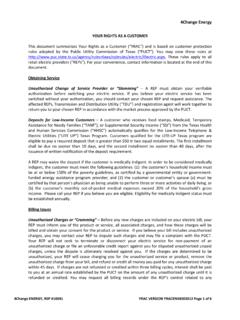Transcription of Batteries Lead-Acid Battery State of Charge vs. …
1 66 Home Power #36 August / September 1993 BatteriesLead-AcidBattery State ofCharge Perez 1993 Richard PerezAbattery voltmeter is the mostbasic system voltmeters areinexpensive, easy to install, and canprovide a wealth of system informationto renewable energy users, RVers, oranyone who depends on a a Voltmeter?Ten years ago, voltmeters were all we had forinformation about our systems. Ampere-hour metersthat calculated Battery efficiency were a pipe now, small systems cannot justify the additionalexpense and complexity of the new sophisticatedbattery State of Charge (SOC) instruments. I still use ahomebrew Battery voltmeter in addition to our hi-techinstruments like the Cruising Amp-hour meter, the SPM2000, and the Power Monitor 15. The voltmeter isalways there, consumes virtually no power, and tells meat a glance what s happening with our a Battery voltmeter and turning that informationinto a reliable assessment of the Battery s State ofcharge is like tracking an animal by its requires noticing small details andextrapolating information from these details.
2 A trackeruses his knowledge of the animal s habits. A trackerconsiders the weather and season. A tracker sknowledge of his subject and its environment allowshim to predict the actions ofhis watching the voltmeter for a few of the Battery scharge/discharge cycles, the user gets a idea of hisbattery s voltage profiles. After watching the voltmeterfor a season or two, the user learns how to relate theeffects of temperature and current on his Battery svoltage. Just like the behavior of animals vary with typeand location, the behavior of Batteries differ with typeand operating Kind of Voltmeter?It really doesn t matter what type of voltmeter you useto measure your Battery s voltage. Better instrumentsyield more accurate measurements with higherresolution. Differences in Battery voltage of VDC aresignificant, so the instrument should have a basicaccuracy at least or better.
3 Accurate analogbattery voltmeters can be purchased for under $ multimeters cost from $40 to $300 and performhighly accurate voltage measurements and much morebesides. Or you can homebrew an expanded scaleanalog Battery voltmeter, see HP #35, Page 92. Youcan homebrew an LED Bat-O-Meter, see HP #10, Page26. Any of these instruments will give you the voltagemeasurement you of a Battery voltmeter is easy. Just connectit to the Battery s main positive and negative buss orterminals. Be sure to get the polarity right becauseanalog meters can be damaged by reverse the Battery voltmeter consumes very little power,the wires feeding it can be small (18 gauge copper orsmaller).Reading the CurvesThe data presented here on the graphs was generatedfrom our set of Trojan L-16W deep cycle lead-acidbatteries. Each Trojan L-16 Battery is composed ofthree series connected, 350 Ampere-hour, lead-acidcells.
4 The graphs and the data here relates to six ofthese Lead-Acid cells in series forming a 12 Volt of you using a 24 Volt system with twelve Lead-Acid cells in series must multiply the voltage in the textand on the charts by two. The voltage versus State ofcharge (SOC) profiles will match those of similarlyconstructed cells. Other types of lead acid cells, like carbatteries, lead-calcium cells, and RV deep cycle Batteries will have different Charge /discharge curves. Ioffer these graphs as examples of what to look for withyour Battery . While specific voltage vs. SOC points willvary from Battery type to Battery type, the shape andrelationship of the curves is similar for all deep cyclelead-acid and Batteries and Ohm s LawBattery voltage can be affected by three factors stateof Charge , current, and temperature. State of Charge iswhat we are trying to find out, so that leaves currentand temperature as factors to reckon means the rate of electron flow through thebattery caused by either Charge or discharge.
5 Every67 Home Power #36 August / September 1993 Batterieselectrochemical cell has internal resistance. As currentmoves through the cell, the cell s voltage changesbecause of this internal cell resistance. When the cell isbeing recharged, current flow causes the cell s voltageto rise. The higher the recharging current the higher thevoltage rise. As the cell is discharged, the dischargingcurrent causes the cell s voltage to drop. The higher thedischarging current, the greater the Battery s batterydepression. This holds true for all electrochemical cellsregardless of type, size, or environment. While absolutevalues vary widely between different acid and alkalinetechnologies, the relationship between current flow andcell voltage remains graphs show a variety of recharge and dischargerates from C/5 to C/100. This C/XX number is actually arate of Charge or discharge in Amperes proportioned tothe capacity of the Battery .
6 For example, consider abattery of 100 Ampere-hours. If you divide this Ampere-hour capacity by 10 hours, then you get a Charge (ordischarge) rate of 10 Amperes. Ten Amperes is a C/10charge (or discharge) rate for a 100 Ampere-hourbattery. Consider another Battery of 500 Ampere-hourscapacity. Here a C/10 rate would be 50 Amperes. Whilethe absolute values of the Charge (or discharge)currents is different between the two Batteries ofdifferent capacity, their effect on the Battery s voltage isthe same. The currents are in the same proportion tothe Batteries voltage is to be related to Battery State of Charge , thenwe must compensate for voltage variation due tocurrent movement through the Battery . Hence there area variety of curves on both the Charge and on the Charge graph is a gray curve entitled Rest . This rest curve is a generic representation of six12 Volt Lead Acid Battery State of Charge (SOC) vs.
7 Voltagewhile Battery is under chargeBattery State of Charge (SOC) in Percent (%) Battery Voltage in Power #36 August / September 1993 Batterieslead-acid cells in series and at Rest. At Rest meansthat no current is moving through the cells, , thatthey are neither being charged or a Battery s State of Charge from voltagemeasurement is vague enough if current is movingthrough the Battery . The vagaries increaseexponentially if no current is moving through thebattery. This is why this curve is and BatteriesThe lead acid reaction is temperature sensitive. Coolingthe cell changes its voltage vs. SOC profile. As thelead-acid Battery cools, its internal resistanceincreases. This means that voltage elevation underrecharging is increased in cold cells. The same internalresistance increase produces increased voltagedepression in cold cells when 32 F (0 C), the effect of temperature becomespronounced enough to distinctly change not only thebattery voltage vs.
8 SOC profile, but also its usefulAmpere-hour capacity. The discharge voltage curvesmay be depressed by as much as VDC from thoseshown on the graph. Charge voltages will be elevatedby as much as VDC for a cold 12 Volt lead-acidbattery. Lead-Acid Internal Resistance and SOCIn Lead-Acid cells, the electrolyte (sulfuric acid)participates in the cell s normal Charge /dischargereactions. As the cells are discharged, the sulfate ionsare bonded to the plates sulfuric acid leaves theelectrolyte. The process is reversed when the cell fully charged Lead-Acid cell has an electrolyte that is a25% solution of sulfuric acid in water (specific gravityabout ). A fully discharged Lead-Acid cell has12 Volt Lead Acid Battery State of Charge (SOC) vs. Voltagewhile under dischargeBattery State of Charge (SOC) in Percent (%) Battery Voltage in 10 2030 4050 607080 90100C/3C/5C/10C/20C/10069 Home Power #36 August / September 1993 Batteriesvirtually no sulfuric acid in its almost pure waterelectrolyte (specific gravity about ).
9 As the sulfuricacid concentration in the electrolyte changes so doesthe electrical resistance of the electrolyte, which in turnchanges the internal resistance of the entire bottom line is that the internal resistance of alllead-acid cells changes with the cell s State of characteristic gives the Lead-Acid reaction itsparticular shape or signature on the voltage vs. SOCgraphs. This signature is unique very different fromalkaline cells whose electrolyte resistance remainsconstant regardless of SOC. The shape of the lead-acidcurves makes it possible to use a voltmeter todetermine a Battery s State of the TracksThe more you understand the relationship betweenbattery voltage and real life events like currentmovement and temperature, the more informationtransferred by a simple voltage measurement. Yourbattery savvy here is worth more than a $400 : Richard Perez, c/o Home Power, POB 520,Ashland, OR 97520 916-475-3179 Northwest Energy Storage presentsThe only industrial Battery in itsfield with the HUPpatent (HighUtilization Positive Plate).
10 The process behind HUPincreases thebattery's expected work life according toextensive testing conducted by the of the competition withprice and or write for your free brochure and price with 7 Year Factory WarrantyFree Shipping 48 StatesDealer Inquiries WelcomeNorthwest Energy Storage10418 Hwy 95 NorthSandpoint, ID 83864 208-263-6142 Offlinecamera inches wide by inches tallABC Power Distribution CentersNow Available with the NewOmniMeter by Sun Selector60 A to 400 A Disconnects$700 & up, send for flyerOmniMeter More Meter Less MoneyIntroductory Offeronly $349includes Charge 35, 60, or 100 Ampere contactornot includedContact:Alternative Power & Light Dell Rd, Cashton, WI 54619608-625-4123 Home Power #9 February/ State of Charge in PERCENT %C/5C/10C/20C/40C/3C/5C/10C/20C/100 DISCHARGECHARGE12 Volt Lead-Acid Battery Chart- 78 Chart- 78 F.







